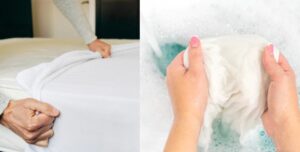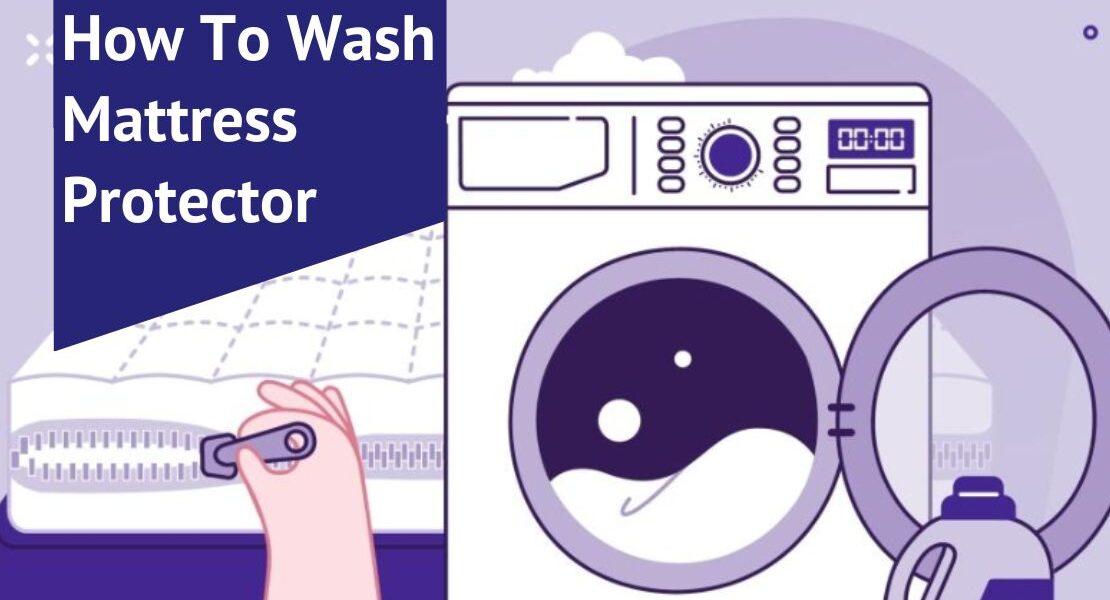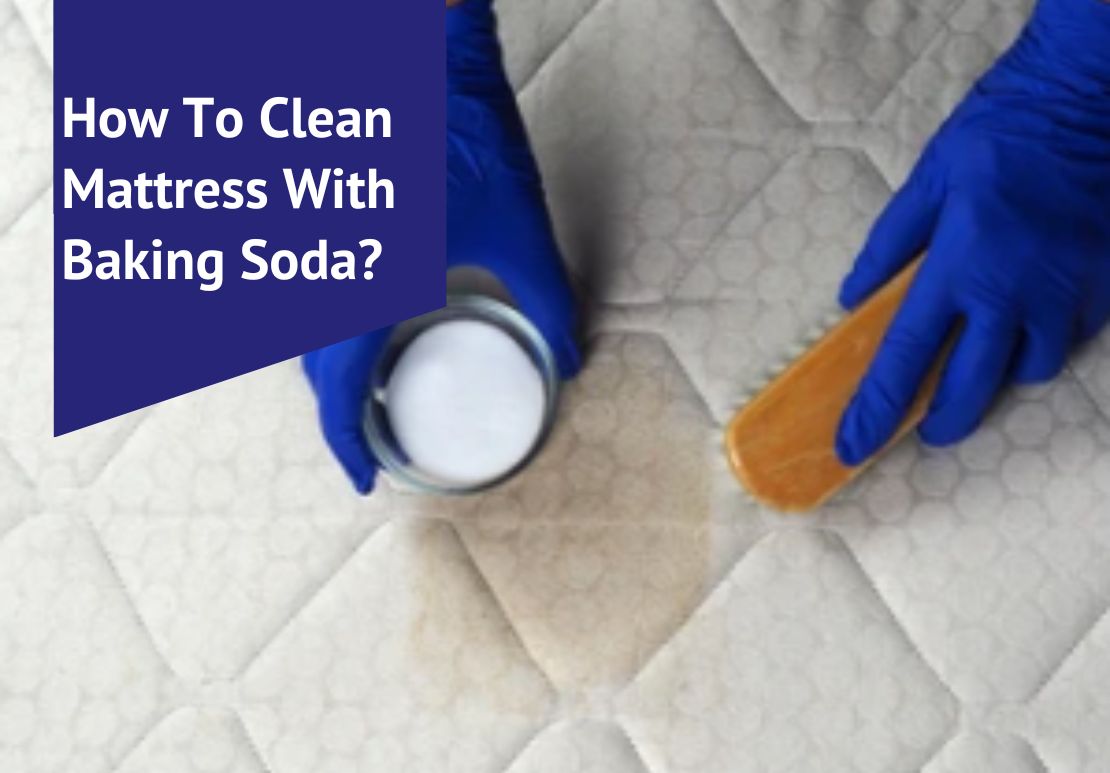Are you struggling with keeping your mattress protector clean and fresh? According to experts, washing your mattress protector every one to two months can significantly extend its lifespan.
Our article provides simple, step-by-step instructions on how to wash a mattress protector properly. Let’s dive into the details of maintaining a hygienic sleeping environment!
Table of Contents
Key Takeaways to Wash Your Mattress Protector Effectively
- Wash your mattress protector every one to two months to maintain cleanliness and extend its lifespan.
- Different types of mattress protectors, such as cotton, vinyl, polyester, down, memory foam, and polyurethane, offer different benefits and require different care.
- Remove all bedding before washing the mattress protector and check the label for specific care instructions.
- Treat stains promptly with a mild detergent before washing in cold or warm water on a gentle cycle.
- Dry the mattress protector either by tumble drying on low heat or air drying in a well-ventilated area.
- For waterproof mattress protectors, spot clean stains immediately and wash in cold water with a mild detergent. Don’t forget to clean your mattress regularly too!
- The frequency of washing depends on factors like guest occupancy and personal preference.
What is a Mattress Protector? Do you really need a mattress protector?
A mattress protector is a removable covering that fits over your mattress to provide an extra layer of protection. It serves the purpose of safeguarding your mattress from stains, spills, dust mites, bed bugs, and other allergens.
There are various types of mattress protectors available in the market, including waterproof, hypoallergenic, and cooling options.

The purpose of a mattress protector
A mattress protector keeps your bed clean and safe. It blocks dirt, dust, and spills from touching your mattress. You can take it off easily to wash it when needed. This helps you have a good sleep in a clean bed every night.
It also makes sure that your mattress will stay nice for longer. So all in all, using a mattress protector is very helpful for many reasons.
Different types of mattress protectors
Homeowners have various types of mattress protectors to pick from. Each type is unique and serves a different role in caring for your mattress.
- Cotton mattress protectors: These are soft and comfy. They are easy to clean in a washing machine.
- Vinyl mattress protectors: These are great at keeping fluids off your bed. But, they can be hot to sleep on.
- Polyester mattress protectors: These are cheap but less comfortable than cotton.
- Down mattress protectors: These give lots of comfort, but they can be hard to clean.
- Memory foam mattress protectors: They offer comfort and support but may trap heat.
- Polyurethane mattress protectors: They keep out dust mites and bed bugs very well.
Why Wash Mattress and Care for a Mattress Protector?
Washing and caring for a mattress protector is essential not only for hygiene and cleanliness reasons but also to prolong the lifespan of your mattress.

Hygiene and cleanliness reasons
Keeping a mattress protector clean is a must for good health. Dirt and germs can build up on it over time. These can lead to bad smells and even sickness. Washing the cover often takes care of this problem.
It keeps you safe from germs that cause diseases. Moreover, sweat or spills may stain the protector. Immediate washing stops these stains from setting in permanently. Thus, cleanliness leads to a fresh bed and sound sleep.
Prolonging the life of your mattress
To prolong the life of your mattress, it’s important to take care of your mattress protector. By regularly washing and maintaining it, you can ensure that your mattress stays in good condition for longer.
Washing the mattress protector every one to two months helps remove dirt, dust, and sweat that can accumulate over time. This not only promotes hygiene but also prevents unwanted odors from developing.
Additionally, washing the mattress protector helps protect your actual mattress from spills and stains that may seep through. By keeping your mattress protector clean and fresh, you are ensuring a comfortable and healthy sleep environment while also extending the lifespan of your mattress.
How to wash the mattress cover in a washing machine?
To wash the mattress cover in a washing machine or washer, follow the below-given guide on how to wash it:
- Remove the mattress protector from the bed.
- Check the label for any specific washing instructions.
- Treat any stains on the mattress cover by dabbing a mild detergent onto them.
- Add the recommended amount of detergent to the washing machine.
- Place the mattress cover in the machine and set it to a gentle cycle.
- Use cold water for washing to prevent shrinkage or damage.
- Let the washing machine complete its cycle.
Instructions and Tips for Washing a Mattress Protector
To wash and clean a mattress protector, start by removing all bedding and checking the label for any specific care instructions.
Removing bedding
To wash your mattress protector, start by removing the bedding from your mattress. Take off the sheets, pillowcases, and any other covers you have on top of the mattress protector.
This will allow you to clean the protector thoroughly without any obstructions. By doing this, you can ensure that all parts of the mattress protector are properly cleaned and maintained.
Cleaning the bedding separately will also help maintain a fresh and hygienic sleep environment for a better night’s rest. Plus, it’s easier to handle and wash smaller items like sheets compared to a larger item like a mattress protector.
Checking the label to know how often should you wash mattress protector
Check the label on your mattress protector to ensure you follow the manufacturer’s instructions for washing and care. The label will provide important information on the specific materials used and any special cleaning recommendations, which will help you learn how to wash the protector and mattress toppers.
It may specify whether the protector is machine washable or if it needs to be hand washed. Following these instructions will help maintain the quality of your mattress protector and prolong its lifespan. Thus, knowing the right way to clean your mattress protector is essential. Also, check the condition of your mattress to know if you need to replace your mattress protector or not.
Keep in mind that different protectors may have different requirements, so always check the label before washing.
Treating stains
To treat stains on your mattress protector, start by gently dabbing a mild detergent onto the affected area. Let it sit for a few minutes to allow the detergent to penetrate the stain.
Then, using a soft cloth or sponge, gently scrub the stain in circular motions. Rinse thoroughly with cold water until all the detergent is removed. If necessary, repeat this process until the stain is completely gone.
It’s important to treat stains promptly to prevent them from setting and becoming more difficult to remove. Regularly treating stains will help keep your mattress protector clean and fresh for longer use.
Adding detergent to remove stains on a mattress protector
To wash your mattress protector, start by adding a mild detergent to the washing machine. Look for a detergent that is gentle and suitable for delicate fabrics. Make sure not to use bleach or any harsh chemicals as they can damage the material of the mattress cover.
Follow the manufacturer’s instructions on how much detergent to use, typically a small amount will suffice. Using too much detergent may cause residue to build up on the protector, which can affect its effectiveness and comfort.
What temperature to wash the mattress protector?
– Wash the mattress protector in cold or warm water.
– Avoid using hot water as it can damage the material and shrink the protector.
– Check the care label for specific temperature recommendations.
– If there are tough stains, pretreat them with a stain remover before washing them.
– Use a gentle cycle to protect the integrity of the fabric.
– Avoid using bleach or harsh chemicals that can weaken or discolor the protector.
- A general guideline is to wash your mattress protector every one to two months.
- Specific situations may require more frequent cleaning, such as stains or spills.
Drying Methods for a Mattress Protector
To dry a mattress protector, homeowners can choose between tumble drying on low heat or air drying.
Tumble drying
One way to dry your mattress protector is by using a tumble dryer. After washing, put the cover in the machine and select a low or medium heat setting. This will help prevent any shrinkage or damage to the fabric.
It’s important to avoid high heat settings as they can cause shrinking or melting of certain materials. Once the drying cycle is complete, remove the mattress protector from the dryer promptly to minimize wrinkles, and fold it neatly before placing it back on your bed.
Tumble drying is a convenient method that ensures your mattress protector is thoroughly dried and ready for use again.
Air drying
To air-dry your mattress protector, simply hang it outside or lay it flat in a well-ventilated area. Air drying is a gentle method that helps prevent shrinkage and damage to the material.
Make sure the protector is completely dry before putting it back on your bed to avoid any mildew or musty smells. If you prefer, you can also put it in front of a fan to speed up the drying process.
Remember, air drying is a great option for preserving the quality of your mattress protector and maintaining its effectiveness over time.
How to wash a waterproof mattress protector?
To wash a waterproof mattress protector, immediately spot clean any stains, then wash it in cold water with a mild detergent to preserve its waterproof properties without causing damage.
Spot clean stains immediately
If you notice any stains on your mattress protector, it’s important to act quickly and spot-clean them right away. Dab a small amount of mild detergent onto the stain and gently blot it with a clean cloth or sponge.
Avoid rubbing the stain as this can make it spread or set deeper into the fabric. After treating the stain, launder the mattress protector according to the washing instructions provided.
Spot-cleaning stains immediately helps prevent them from becoming more difficult to remove and keep your mattress protector looking fresh and clean for longer.
Wash with cold water
To wash the mattress protector, use cold water. Cold water is gentle on the fabric and helps to prevent any shrinkage or damage. By using cold water, you can effectively clean the mattress cover without compromising its quality.
Remember to always check the care label for specific washing instructions before proceeding.
Use a mild detergent
To wash your mattress protector, it’s important to use a mild detergent. This helps to effectively clean the cover without harsh chemicals that could damage the fabric. Look for a detergent that is gentle and suitable for delicate fabrics.
Avoid using bleach or strong detergents as they can break down the fibers of the mattress protector. By using a mild detergent, you can ensure that your mattress protector stays clean and fresh without causing any harm to its material or compromising its effectiveness in protecting your mattress.
Don’t neglect to clean your mattress
Cleaning your mattress is just as important as washing your mattress protector. Neglecting to clean your mattress can lead to the buildup of dust, dirt, and allergens, which can affect the quality of your sleep and potentially cause health issues.
Regularly vacuuming your mattress and spot-cleaning any stains can help maintain a clean sleeping environment. Additionally, rotating and flipping your mattress every few months can prevent uneven wear and prolong its lifespan.
So, don’t forget to give your mattress some attention when it comes to cleaning and care!
How Often to Wash a Mattress Protector
The frequency of washing a mattress protector depends on various factors such as guest occupancy, allergies, and personal preference.
Guidelines for different situations (guest bedrooms, allergy sufferers, etc.)
Different situations may require specific guidelines for washing your mattress protector:
- Guest bedrooms:
- Wash the mattress protector after each guest leaves to maintain cleanliness.
- Follow the manufacturer’s instructions for washing and drying.
- Spot clean any stains immediately to prevent them from setting.
- Allergy sufferers:
- Wash the mattress protector every two weeks or more frequently if needed.
- Use hot water (according to label instructions) to kill dust mites and allergens.
- Consider using hypoallergenic detergent to minimize potential irritants.
- Pets or children:
- Wash the mattress protector once a month or as needed, depending on accidents or spills.
- Look for a waterproof or stain-resistant option for added protection against spills and stains.
- Treat stains promptly with mild detergent before washing.
- Bedwetting:
- Wash the mattress protector immediately after accidents occur.
- Use cold water and mild detergent to remove odors and stains effectively.
- Consider adding vinegar or baking soda during the wash cycle for additional odor removal. However, it should align with the manufacturer’s instructions.
- Regular use:
- Follow the general guideline of washing your mattress protector every one to two months.
- Check for any stains, spills, or odors regularly and address them promptly.
- Air dry or tumble dry on low heat according to the manufacturer’s instructions.
Conclusion
Washing your mattress protector regularly is essential for maintaining a clean and hygienic sleep environment. By following the proper washing instructions, such as removing it from the mattress, treating stains, and using a gentle cycle, you can keep your mattress protector in great condition for longer. Also, keep checking the condition of the mattress to know if you need to replace your mattress or not.
Remember to spot-clean any spills or stains immediately to prevent them from setting in. Also, keep your mattress protector clean to ensure a comfortable and healthy night’s sleep.
Frequently Asked Questions
Can I machine wash my mattress protector?
Yes, most mattress protectors can be safely machine-washed. Check the care instructions on the label for specific washing guidelines.
How often should I wash my mattress protector?
It is recommended to wash your mattress protector every 1-2 months or as needed, especially if there are any spills, stains, or odors.
Can I use bleach when washing a mattress protector?
No, it is not recommended to use bleach when washing a mattress protector as it can damage the fabric and shorten its lifespan. Use mild laundry detergent instead.
Can I tumble dry my mattress protector?
Yes, most mattress protectors can be tumble dried on low heat or no heat settings. Again, check the care instructions for specific drying recommendations.
Can I iron my mattress protector?
No, ironing is generally not necessary for a mattress protector and may cause damage to the fabric. Allow it to air dry or follow the care instructions provided by the manufacturer.

 Image source - purple
Image source - purple 





